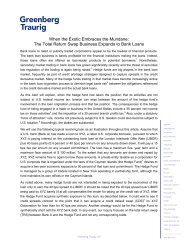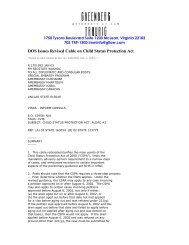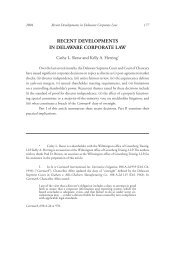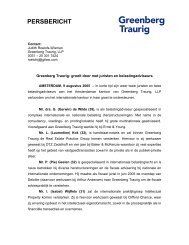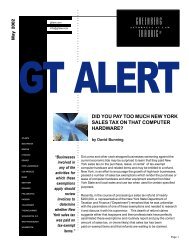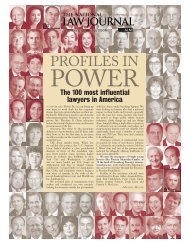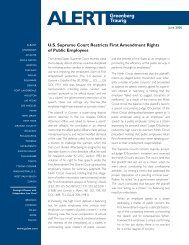The Private Trust Company - Greenberg Traurig LLP
The Private Trust Company - Greenberg Traurig LLP
The Private Trust Company - Greenberg Traurig LLP
Create successful ePaper yourself
Turn your PDF publications into a flip-book with our unique Google optimized e-Paper software.
the PTC and participated in the daily activities<br />
of the PTC without causing the value of the<br />
trusts to be included in their estates for federal<br />
estate tax purposes; 4 and<br />
� For generation-skipping transfer tax purposes,<br />
naming a PTC as trustee did not adversely impact<br />
a trust’s exempt status. 5<br />
Preferred PTC Structure Based on PLRs<br />
<strong>The</strong> three PLRs seem to provide the boundaries for<br />
structuring the PTC – from most restrictive to<br />
somewhat flexible. <strong>The</strong> PTCs examined in the PLRs<br />
included the following key features:<br />
� <strong>The</strong> board of directors had at least one board<br />
member that was not a family member, or a<br />
grantor of, a donor to, or a current or contingent<br />
beneficiary of a trust (i) of which any family<br />
member was a grantor, donor, or current or<br />
contingent beneficiary and (ii) for which the<br />
trustee had any discretionary power (other<br />
than an investment power) that was not limited<br />
by an ascertainable standard; 6<br />
� In PLR 20053003, the board of directors<br />
appointed a Distribution Committee (a/k/a<br />
Discretionary Decisions Review Committee in<br />
PLRs 200546055 and 200548035) to make<br />
discretionary distributions of trust principal<br />
and income.<br />
� In all three PLRs, the Distribution Committee<br />
was subject to restrictions with regard to<br />
discretionary distributions of trust principal and<br />
income. <strong>The</strong> restrictions were critical in<br />
protecting the grantor and beneficiaries from<br />
causing the value of the trusts to be included in<br />
their estates for federal estate tax purposes.<br />
PLR 200523003 provided strict rules regarding the<br />
composition of the Distribution Committee. <strong>Trust</strong><br />
grantors (and their spouses) as well as current and<br />
contingent beneficiaries (and their spouses) were<br />
prohibited from serving on the Distribution<br />
Committee. Any person considered related or<br />
subordinate to a grantor or current or contingent<br />
beneficiary was also prohibited from serving on<br />
the Distribution Committee. No member of the<br />
Distribution Committee could participate in any<br />
discretionary decision with respect to any trust<br />
beneficiary to whom he or she owed a legal obligation<br />
of support. And the majority of the<br />
Distribution Committee members could not be<br />
employees or directors of the PTC.<br />
In contrast, PLRs 200546055 and 200548035 provided<br />
more flexibility with respect to discretionary<br />
distributions. Initial discretionary distribution decisions<br />
were made by PTC trust officers subject to<br />
review by senior trust officers. Upon the written<br />
request of a beneficiary, the Distribution<br />
Committee (appointed by the PTC’s board of<br />
directors and comprised of at least three directors)<br />
would review the discretionary distribution<br />
decisions made by the PTC trust officers. A variety<br />
of restrictions prevented this arrangement<br />
from causing estate tax inclusion for the grantor<br />
and beneficiaries. For example, discretionary distributions<br />
decisions were required to be made by<br />
non-family PTC trust officers, and PTC officers and<br />
directors were prohibited from participating in any<br />
discretionary distribution decision with respect to<br />
a trust if the officer or director, or his or her spouse,<br />
is a grantor, donor, or a current or contingent beneficiary;<br />
or if the officer or director, or his or her<br />
spouse, is a family member.<br />
Conclusion<br />
PTCs offer high net-worth families significant flexibility.<br />
Three recently issued PLRs provide important<br />
guidance for advisors on how to structure and<br />
operate a PTC in order to avoid common estate<br />
planning pitfalls. As a result of this guidance, PTCs<br />
may become more widely utilized.<br />
<strong>The</strong> <strong>Private</strong> <strong>Trust</strong> <strong>Company</strong> – A Fiduciary Services<br />
and Asset Management Alternative for High Net-Worth Families Page 2



